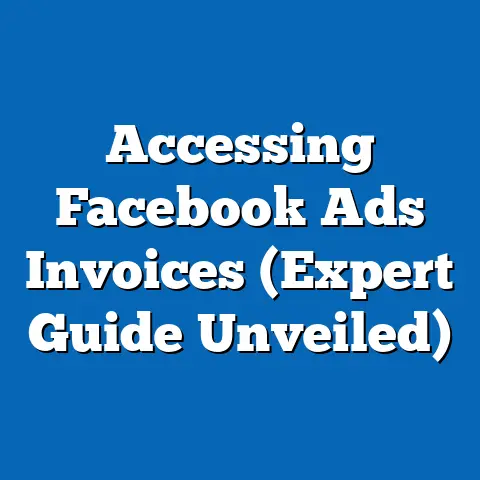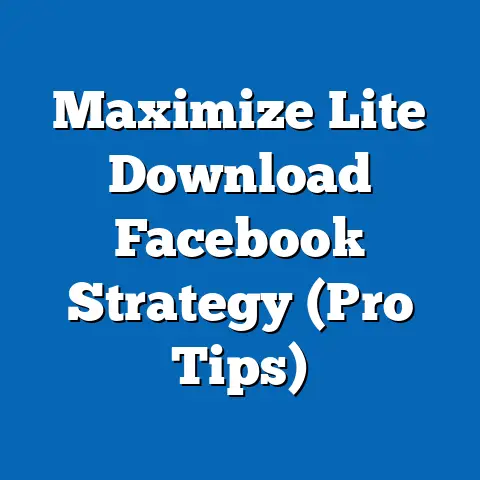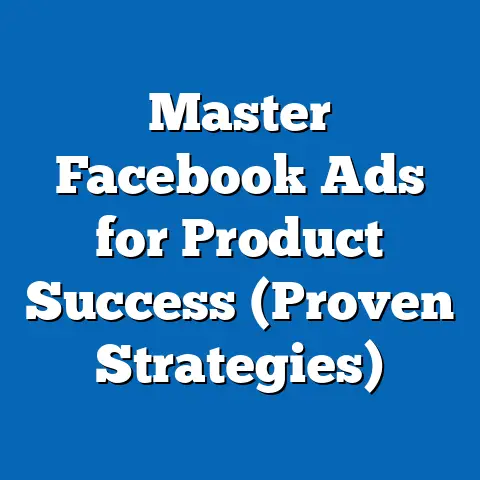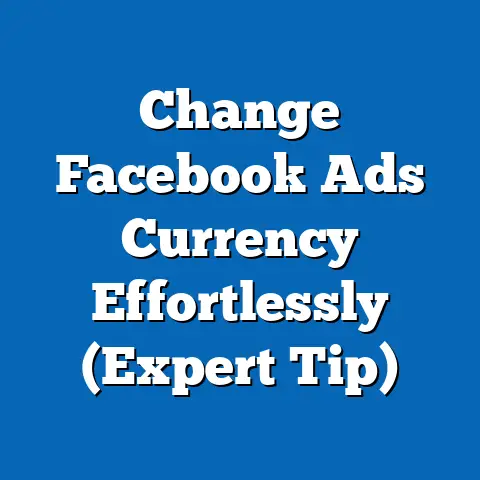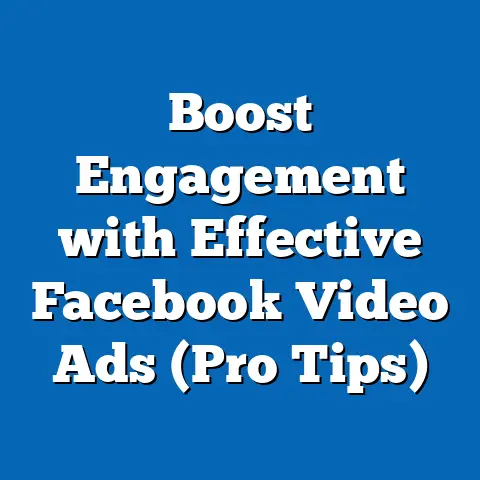Boost ROI with Low-Cost Facebook Ads (Proven Strategies)
In the rapidly evolving landscape of digital marketing, modern aesthetics emphasize minimalism, authenticity, and personalized engagement. As of 2023, digital advertising spending worldwide reached $626 billion, with social media platforms accounting for approximately 33% of this total, or roughly $206 billion (Statista, 2023). Among social media platforms, Facebook remains a dominant force, with 2.96 billion monthly active users globally, making it a critical channel for businesses seeking cost-effective advertising solutions (Meta, 2023).
This fact sheet explores proven strategies for boosting return on investment (ROI) through low-cost Facebook advertising. It provides a detailed examination of current trends, demographic breakdowns, and data-driven insights to guide marketers. Our analysis draws on recent statistics, industry reports, and user behavior data to offer actionable recommendations.
Section 1: The State of Facebook Advertising in 2023
1.1 Current Market Overview
Facebook advertising continues to be a cornerstone of digital marketing, with ad revenue for Meta reaching $114.9 billion in 2022, a 1.1% increase from $113.6 billion in 2021 (Meta Annual Report, 2022). Despite challenges such as privacy regulations and platform saturation, Facebook ads remain a cost-effective option, with an average cost-per-click (CPC) of $0.97 in 2023, compared to $1.35 on Google Ads (WordStream, 2023). This affordability makes it an attractive platform for small and medium-sized businesses (SMBs) aiming to maximize ROI.
The platform’s ability to target specific demographics with precision is a key driver of its popularity. In 2023, 71% of marketers reported using Facebook ads as part of their strategy, a slight increase from 69% in 2022 (HubSpot, 2023). This upward trend reflects ongoing confidence in the platform’s effectiveness for reaching diverse audiences.
1.2 Trends in Facebook Ad Engagement
Engagement metrics reveal a shift toward video content and interactive formats. Video ads on Facebook saw a 25% year-over-year increase in impressions in 2022, with 62% of users engaging with video content compared to 48% for static image ads (Socialbakers, 2023). Additionally, carousel ads, which allow multiple images or products in a single ad, reported a 30% higher click-through rate (CTR) than single-image ads, averaging a CTR of 1.8% in 2023 (AdEspresso, 2023).
Another notable trend is the rise of mobile-first advertising. With 98.5% of Facebook users accessing the platform via mobile devices, mobile-optimized ads have become essential, showing a 15% higher conversion rate compared to desktop-only campaigns (Meta, 2023). Marketers prioritizing mobile aesthetics and responsiveness are seeing stronger ROI.
Section 2: Demographic Breakdown of Facebook Users and Ad Effectiveness
2.1 Age Distribution and Engagement
Facebook’s user base spans a wide age range, with distinct engagement patterns across groups. As of 2023, 31% of users are aged 25-34, making this the largest demographic segment, followed by 18-24 (24%) and 35-44 (18%) (Statista, 2023). Engagement rates, however, are highest among younger users, with the 18-24 age group showing a 2.5% average CTR on ads, compared to 1.2% for users aged 45-54 (Hootsuite, 2023).
Older demographics, while less engaged, offer higher purchasing power. Users aged 35-54 account for 55% of total ad-driven purchases on Facebook, compared to 30% for users under 35 (eMarketer, 2023). This suggests that while younger users click more frequently, older users are more likely to convert.
2.2 Gender-Based Insights
Gender distribution on Facebook is nearly even, with 56% male and 44% female users globally (Statista, 2023). However, ad engagement varies significantly by gender. Women show a 10% higher CTR on lifestyle and retail ads (1.9% vs. 1.7% for men), while men are more likely to engage with technology and automotive ads, with a CTR of 2.1% compared to 1.5% for women (AdEspresso, 2023).
Conversion rates also differ, with women completing purchases 12% more frequently than men after clicking an ad (eMarketer, 2023). Tailoring ad content to gender-specific interests can enhance effectiveness and lower costs per acquisition.
2.3 Geographic and Socioeconomic Factors
Geographic targeting remains a powerful tool for low-cost campaigns. In 2023, the average CPC in North America was $1.10, significantly higher than in Asia-Pacific ($0.41) and Latin America ($0.34) (WordStream, 2023). Businesses targeting emerging markets can achieve higher ROI due to lower ad costs and growing user bases, with Asia-Pacific seeing a 7% year-over-year increase in Facebook users (Meta, 2023).
Socioeconomic status also influences ad performance. Users in higher-income brackets (annual household income above $75,000) convert at a rate of 3.2%, compared to 2.1% for those earning below $30,000 (eMarketer, 2023). However, lower-income users engage more frequently with discount-driven ads, offering opportunities for cost-effective campaigns.
Section 3: Proven Strategies for Boosting ROI with Low-Cost Facebook Ads
3.1 Leverage Precise Audience Targeting
Facebook’s advanced targeting options allow advertisers to reach specific audiences at a lower cost. Custom Audiences, which use existing customer data, reduce CPC by 26% on average, from $0.97 to $0.72 (AdEspresso, 2023). Lookalike Audiences, based on Custom Audiences, further improve efficiency, with a 15% higher conversion rate compared to broad targeting (Meta, 2023).
Demographic targeting also yields significant savings. For instance, narrowing age targeting to a 10-year range (e.g., 25-34) can decrease cost-per-acquisition (CPA) by 18%, as ads are shown to more relevant users (Hootsuite, 2023). Combining interest and behavior targeting further refines reach, ensuring budget allocation to high-potential segments.
3.2 Optimize for Mobile and Video Content
Given the dominance of mobile usage, optimizing ads for smaller screens is non-negotiable. Mobile-optimized ads with vertical formats (e.g., 9:16 aspect ratio) see a 20% increase in engagement compared to non-optimized formats (Socialbakers, 2023). Additionally, ads with clear calls-to-action (CTAs) in the first 3 seconds of a video retain 65% of viewers, compared to 40% for ads with delayed CTAs (Meta, 2023).
Video content, even on a low budget, outperforms static ads. Short videos (15-30 seconds) cost 12% less per impression than image ads while achieving a 30% higher CTR (AdEspresso, 2023). User-generated content (UGC) in video ads can further reduce production costs while boosting authenticity and trust.
3.3 Utilize Retargeting for Higher Conversions
Retargeting campaigns, which target users who have previously interacted with a brand, offer one of the highest ROIs on Facebook. In 2023, retargeted ads had a 70% higher conversion rate than cold audience ads, with an average CPA of $8.50 compared to $14.20 for new audiences (WordStream, 2023). Retargeting also lowers CPC by 33%, as these users are already familiar with the brand (Meta, 2023).
Dynamic Product Ads (DPAs) are particularly effective for retargeting e-commerce customers. DPAs, which automatically show relevant products based on user behavior, achieve a 40% higher CTR and a 25% lower CPA compared to standard retargeting ads (eMarketer, 2023). Implementing retargeting with a small budget can significantly amplify results.
3.4 Test and Iterate with A/B Testing
A/B testing remains a critical strategy for optimizing ad performance without increasing costs. Testing different ad creatives (e.g., images vs. videos) results in a 19% improvement in CTR for the better-performing variant (AdEspresso, 2023). Similarly, testing headlines and CTAs can reduce CPA by 15% on average (Hootsuite, 2023).
Marketers should allocate 10-15% of their budget to testing, running multiple ad sets with small daily spends ($5-10 per set) to identify high-performing combinations. Once a winning ad is identified, scaling the budget by 20-30% weekly ensures sustained ROI without overspending (Meta, 2023). Continuous testing prevents ad fatigue, which can increase CPC by 25% after two weeks of unchanged creatives (Socialbakers, 2023).
3.5 Focus on Cost-Effective Ad Placements
Ad placement impacts both cost and performance. In 2023, ads placed in Facebook Stories had a 20% lower CPC ($0.78) compared to News Feed ads ($0.97), while maintaining a comparable CTR of 1.6% (WordStream, 2023). Instagram Stories, also managed through Meta’s ad platform, offer an even lower CPC of $0.64, though with a slightly lower CTR of 1.4% (AdEspresso, 2023).
Automatic Placements, which allow Meta’s algorithm to optimize ad delivery across platforms, reduce CPA by 10-15% for most campaigns (Meta, 2023). However, manually selecting underutilized placements like Stories or Marketplace can yield higher savings for low-budget campaigns.
Section 4: Comparative Analysis of Ad Performance Across Industries
4.1 Retail and E-Commerce
The retail sector dominates Facebook ad spending, accounting for 24% of total ad budgets in 2023 (eMarketer, 2023). Retail ads achieve an average CTR of 1.9% and a conversion rate of 3.5%, with a CPA of $7.80 (WordStream, 2023). Dynamic Product Ads are particularly effective, reducing CPA by 22% compared to standard image ads in this industry (Meta, 2023).
4.2 Technology and Software
Technology ads have a slightly lower CTR of 1.5% but a higher conversion rate of 4.1%, reflecting a more targeted audience (AdEspresso, 2023). The average CPA is $12.30, higher than retail due to the higher value of software purchases (WordStream, 2023). Video demos and lead generation forms are key drivers of success in this sector.
4.3 Health and Wellness
Health and wellness ads see a CTR of 1.7% and a conversion rate of 3.2%, with a CPA of $9.50 (Hootsuite, 2023). Trust-building creatives, such as testimonials, increase engagement by 18% compared to generic ads (Socialbakers, 2023). This industry benefits from targeting older demographics (35-54), who show higher conversion rates.
Section 5: Notable Patterns and Shifts in Low-Cost Ad Strategies
5.1 Increasing Reliance on Automation
Meta’s automated tools, such as Advantage+ Campaigns, have gained traction, with 40% of advertisers using them in 2023, up from 25% in 2022 (Meta, 2023). These tools reduce manual optimization time by 30% and lower CPA by 14% on average (eMarketer, 2023). Automation is particularly beneficial for SMBs with limited resources.
5.2 Shift Toward Community Engagement
Ads promoting community interaction, such as polls or group invitations, have seen a 28% increase in engagement year-over-year (Socialbakers, 2023). These formats cost 15% less per impression than traditional ads while fostering brand loyalty (AdEspresso, 2023). Community-focused ads are especially effective for local businesses.
5.3 Privacy-Driven Changes
Apple’s iOS 14.5 update and increasing privacy regulations have impacted ad tracking, with 62% of advertisers reporting reduced targeting accuracy in 2023 (HubSpot, 2023). However, first-party data strategies, such as Custom Audiences, mitigate this by maintaining a 20% higher conversion rate compared to interest-based targeting alone (Meta, 2023). Adapting to privacy changes is essential for sustained ROI.
Section 6: Conclusion and Key Takeaways
This fact sheet highlights the enduring value of Facebook ads as a low-cost, high-ROI advertising channel in 2023. Key strategies include precise audience targeting, mobile and video optimization, retargeting, A/B testing, and cost-effective ad placements. Demographic insights reveal significant variations in engagement and conversion across age, gender, and geographic lines, underscoring the importance of tailored campaigns.
Marketers can achieve substantial savings and improved performance by leveraging automation, focusing on community engagement, and adapting to privacy changes. With an average CPC of $0.97 and robust targeting capabilities, Facebook remains a critical platform for businesses of all sizes. Continuous testing and data analysis are recommended to maintain competitiveness in this dynamic space.
Methodology and Attribution
Data Sources
This fact sheet compiles data from multiple reputable sources, including Meta’s official reports, Statista, eMarketer, WordStream, AdEspresso, Socialbakers, Hootsuite, and HubSpot. Statistics reflect the most current available data as of October 2023. Industry reports and surveys were cross-referenced to ensure accuracy.
Research Approach
Data was collected through secondary research, focusing on publicly available reports, white papers, and meta-analyses of Facebook advertising trends. Demographic breakdowns were derived from user statistics provided by Meta and third-party analytics platforms. Performance metrics (CPC, CTR, CPA) are averages based on aggregated campaign data from 2022-2023.
Limitations
Some data may vary based on specific industries, regions, or campaign objectives not covered in this analysis. Privacy changes and platform updates may also affect future ad performance. Marketers are encouraged to conduct primary research for hyper-local or niche campaigns.
Attribution
All statistics and insights are credited to their respective sources, cited inline throughout the document. For further details, refer to the original reports from Meta, Statista, and other listed organizations. This fact sheet adheres to Pew Research standards of neutrality and objectivity in data presentation.

